If you have a bird with cut flight feathers or are thinking of doing this deed this is the article to read.
Part Two: The Benefits to Them – Pamela Clark, CPBC
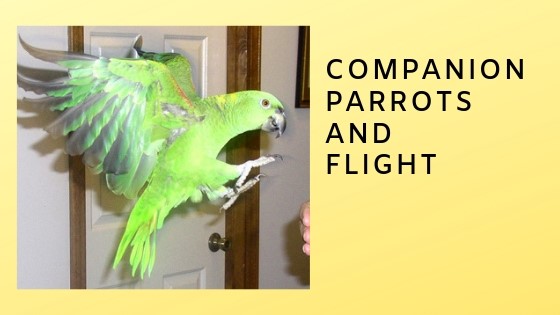
Part Two: The Benefits to Them
Suggested Ground Rules
Before I begin my exploration of the many benefits of flight for companion parrots, I want to suggest something. My last episode on this topic has generated animated debate, especially on one site to which it was shared. A total of 55 messages (and still counting) illustrate perfectly what I have said before – that radical bias and lack of information play much too large a role in this discussion.

One of the reasons why we have not achieved more progress on this issue is that many people advise others, using information they are merely repeating after having read it elsewhere. Moreover, they have become inexplicably committed to this second-hand information. In addition, many who are knowledgeable in general about parrots feel compelled to also offer advice in areas in which they are not – such as this topic.
I suggest, going forward, that if you do not have years of experience living with flighted parrots in your home, then in this conversation you are alearner. Only by approaching with intellectual humility subjects such as this, will we create the more functional and truly informative discussion that is needed.
Let’s Get Straight About Definitions
For the purposes of this discussion, a fully flighted parrot is an unclipped bird who chooses to fly frequently as his primary means of locomotion inside the home. It does not refer to parrots with unclipped wings who do not choose to fly.
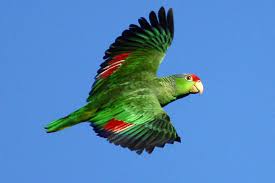
A free flighted parrot is one who is allowed to fly outdoors at liberty. That activity is not within the scope of this discussion. While I have trained companion parrots for free flight, this is not an activity that I advocate except for the rare few. For those of you interested in free flight, trainer Hillary Hankey has written an excellent article about this practice.
The Fledging Process and Brain Development
Fledging is the process through which young parrots learn to fly. The urge to fly is instinctive – every young parrot will at some point launch himself into the air if given the opportunity. However, flight skills must be learned through much practice.
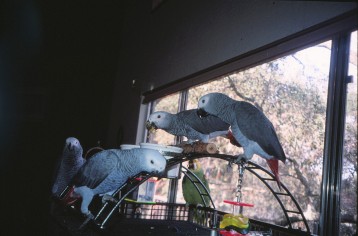
Twenty years ago, it was common to read the statement: “African Greys are nervous, clumsy birds.” At the time I began breeding, I thought this was about the stupidest thing I had ever heard. How could this be? How could they survive in the wild with these qualities?
The truth? An African Grey parrot who was fully fledged is an entirely different adult parrot than one who did not. It is no different for any other species of parrot. Learning to fly impacts all aspects of the young parrot’s development.
“The fledging process itself contributes in many ways to long-term success for psittacine companions because during fledging, early behaviors culminate in a fully active animal totally engaged in and interactive with its environment, including human caretakers.” Further, fledging babies “does not result in cookie-cutter companions but the reverse. When raised in environments tailored to their growth, psittacine companions develop individual personalities, preferences and propensities.” (Linden, P. 2006)
The benefits of learning to fly, however, may extend beyond the coordination, confidence, and autonomy that result from the physical experience.
Development of the Senses
Steve Hartman of The Parrot University writes: “Babies learn best when multiple senses are stimulated simultaneously (i.e.; sight, sound, taste, touch, and smell). The best opportunity for a parrot to learn is when a combination of senses are experienced at the same time. The senses of sight, sound and touch take on a very different nature during flight. When a particular skill is being developed or experienced by different senses at the same time a different neuropathway is reinforced for each sense creating a much stronger neurocircuitry for that skill or knowledge being learned.”
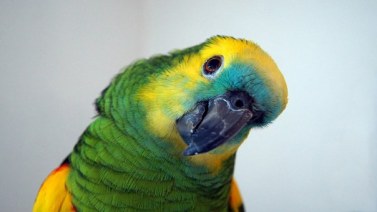
“Each one of the senses, as well as mental and physical skills develop over a period of time, but not at the same time. Some of the development phases are symbiotic, meaning they need information being developed in another area of the brain for their own optimal development. For example, vision develops best when the baby can move around and see things from different angles and distances. Conversely, coordination develops best when the visual cortex can provide information on distance and perspective. Without this symbiotic relationship of vision and coordination, it is difficult to develop three-dimensional vision.” (Hartman, S. 2007)
“The faster he flies, the faster the visual ability needs to be and the faster the brain learns to process the information, and the faster he will be able to fly. Teaching the brain to process information faster and on higher levels, promotes faster decision-making and fewer mistakes in all areas of mental, physical and social competence.” (Hartman, S. 2007)

In Hartman’s piece, no research sources are listed. Such investigation through controlled studies has been absent to date. After all, why research the benefits of flight to companion parrots if we are dedicated to preventing this as a group of caregivers, as we have been previously?
However, evidence does exist for humans, as documented by the authors in The Role of Locomotion in Psychological Development: “The psychological revolution that follows the onset of independent locomotion in the latter half of the infant’s first year provides one of the best illustrations of the intimate connection between action and psychological processes. In this paper, we document some of the dramatic changes in perception-action coupling, spatial cognition, memory, and social and emotional development that follow the acquisition of independent locomotion.” (Anderson, D et al. 2013)
Were we to research further, we would find it true for all animals. The timely acquisition of a creature’s natural means of locomotion fosters more complete brain and personality development.
Benefits of Flight for the Adult Parrot
The fully flighted parrot enjoys physical, social, and psychological benefits far in excess of his wing clipped compatriot.
Physical Health
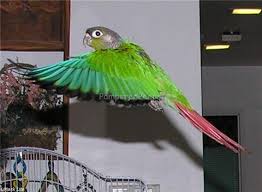
The parrot who flies to get around the home enjoys far greater health benefits, including stronger musculature, greater resistance to disease due to improved immune function, and better function of cardiac and respiratory systems. There is simply no way that clipped birds can achieve the same level of exercise through walking, climbing, and flapping exercises. (Glendell, G. 2017)
“Birds were made to fly and when they don’t, they develop problems similar to humans who do not exercise; they are more prone to obesity as well as liver, kidney, and heart disease. More over, studies of the bones of the wings and legs of our companion birds are currently being investigated under the lead of Dr. Scott Echols at University of Utah Medical Center in Salt Lake City. The bone density comparisons of birds that are “perch potatoes” are very poor in comparison to wild birds. This metabolic bone disease may contribute to other medical conditions, but the extent is not known yet.” (Orosz, S. 2014)
Improved vision

Hartman suggests that parrots who live with clipped wings may have poorer vision. “Flying birds quickly learn to process visual inputs faster as they develop and reinforce new and improved pathways for routing visual stimulus at high speeds in a three dimensional manner. This educational process cannot take place without flight. Parrots with poor visual skills take longer to assess visual stimulus which may cause the bird to need to react aggressively until the information is processed. For instance, a new person entering the room or someone reaching out to touch may provoke ‘a bite first ask later’ response while the circumstances are being processed.” (Hartman, S. 2007)
Dr. Kenneth Welle concurs: “The use of flight for mental stimulation is very important — birds were designed to fly and the scenery rushing past them stimulates the optic cortex of their brain.” (Orosz, S. 2016)
physical safety
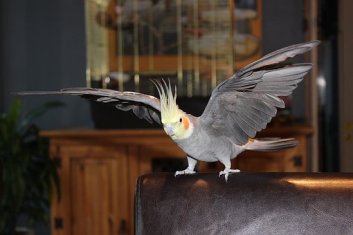
While much has been written about the risks that exist in the home for flighted parrots, these are quite easily managed through both training and careful environmental arrangement. In reality, the flighted parrot may enjoy greater physical safety due to his ability to escape unsafe situations.
If a flighted parrot finds himself on the floor with other family pets, he is easily able to fly upward to escape unwanted interaction. If he discovers he is heading toward the stove or other unsafe surface, he can hover and change direction. (A clipped bird who launches himself into uncontrolled flight has no such ability.) If he lands on another parrot’s cage, he can simply fly off before he loses a toe or two.
social functionality
Companion parrots who fly are in general more socially adept than those who do not. They quite naturally maintain their autonomy, better able to make choices about when and where to interact with members of the “family flock.”
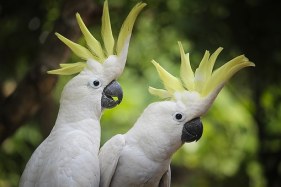
“The social interactions of clipped birds often land on the side of “overdependent” because, lacking their own resources for exploration, they depend upon human caregivers for entertainment, transportation, and to save them from less-favored persons.” (Linden, P. 2006)
Flighted parrots also are able to make that age-old choice between flight and fight. If able, a parrot who doesn’t like what’s going on will simply fly off. As Linden explains: “Flighted birds flee from unsolicited interest and so find biting largely unnecessary, but clipped birds, lacking escape, often bite to drive away perceived intruders and other annoyances.”
psychological benefits
Flighted birds are better able to exercise their own autonomy, making a stream of choices throughout the day and expressing their natural behaviors. For example, my flighted parrots will engage in foraging for hours throughout the day, since I have food placed in several locations around my home.
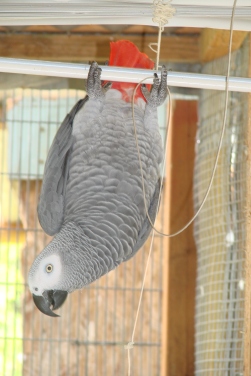
Parrots who fly are at less risk for developing fear-based behaviors. They are better able to cope with stressful situations and recover more quickly due to the generalized feelings of safety that they experience as a result of being able to use flight for escape.
Quality of life is directly tied to the number of choices that a captive animal is able to make. Flighted parrots are able to make an abundance of choices when out of their cages, since they can perch where they want, eat where they want, and interact with whom they want.
The Obvious Action Step
The benefits of flight to both developing and adult companion parrots are irreplaceable and undeniable. No matter how diligent a caregiver might be, there is no way to fully compensate for a lack of flight ability. I do not believe that it is possible for a clipped parrot to enjoy the same physical, emotional, and psychological health that the flighted parrot enjoys.
As Matt Smith states: “What parrots want is flight and flock – the two things they’re denied as pets in most homes.” In my experience, the one guarantees the other.
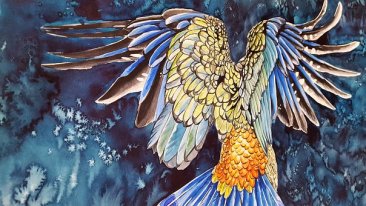
A discussion such as this does little to advance quality of life for companion parrots. What we need are action steps that will create the greatest impact.
No one should adopt a baby parrot from a breeder or pet store if that bird has not been fully fledged for a number of weeks. Not all adult parrots can regain flight ability after being deprived of the opportunity during that natural developmental stage for learning. This one single step would have a significant impact on quality of life for parrots going forward. Voting with our dollars creates change.
In my next blog post, I will explore the many benefits to the caregiver of keeping flighted parrots. Until then!
Thank you for reading my blog. I am Pamela Clark, an IAABC Certified Parrot Behavior Consultant and veterinary technician. My passion is helping people with parrots. To access free resources or subscribe to my newsletter (which is a different publication from this blog), please visit me at http://www.pamelaclarkonline.com. Until next time!
Resources:
Anderson, D. I., Campos, J. J., Witherington, D. C., Dahl, A., Rivera, M., He, M., Uchiyama, I., … Barbu-Roth, M. (2013). The role of locomotion in psychological development. Frontiers in psychology, 4, 440. doi:10.3389/fpsyg.2013.00440 Accessed 03/19/2019.
Bergman, Charles. 2013. No Fly Zone: Denied their natural habits, millions of pet parrots lead bleak, lonely lives. The Humane Society of the United States. No-fly zone: Denied their natural habits, millions of pet parrots lead bleak, lonely lives | The Humane Society of the United States. Accessed 03/26/2019.
Glendell, G. 2017. Birds Need to Fly. The IAABC Journal. Birds Need to Fly - The IAABC Journal - Spring 2017. Accessed 03/24/2019.
Hartman, Steve. 2007. Thinking on the Wing.The Parrot University. Thinking on the Wing | The Parrot University, llc. Accessed 03/26/2019.
Linden, Phoebe Greene with Leuscher, Andrew. 2006. The Manual of Parrot Behavior. Ames, Iowa: Blackwell Publishing. Pages 93-111.
Moser, Dean. 2004. Parrot and Flight: Flight and the Companion Parrot.AFA Watchbird: Journal of the American Federation of Aviculture. Parrots and Flight: Flight and the Companion Parrot | Moser | AFA Watchbird. Accessed 03/27/2019.
Part Two: The Benefits to Them – Pamela Clark, CPBC

Part Two: The Benefits to Them
Suggested Ground Rules
Before I begin my exploration of the many benefits of flight for companion parrots, I want to suggest something. My last episode on this topic has generated animated debate, especially on one site to which it was shared. A total of 55 messages (and still counting) illustrate perfectly what I have said before – that radical bias and lack of information play much too large a role in this discussion.

One of the reasons why we have not achieved more progress on this issue is that many people advise others, using information they are merely repeating after having read it elsewhere. Moreover, they have become inexplicably committed to this second-hand information. In addition, many who are knowledgeable in general about parrots feel compelled to also offer advice in areas in which they are not – such as this topic.
I suggest, going forward, that if you do not have years of experience living with flighted parrots in your home, then in this conversation you are alearner. Only by approaching with intellectual humility subjects such as this, will we create the more functional and truly informative discussion that is needed.
Let’s Get Straight About Definitions
For the purposes of this discussion, a fully flighted parrot is an unclipped bird who chooses to fly frequently as his primary means of locomotion inside the home. It does not refer to parrots with unclipped wings who do not choose to fly.

A free flighted parrot is one who is allowed to fly outdoors at liberty. That activity is not within the scope of this discussion. While I have trained companion parrots for free flight, this is not an activity that I advocate except for the rare few. For those of you interested in free flight, trainer Hillary Hankey has written an excellent article about this practice.
The Fledging Process and Brain Development
Fledging is the process through which young parrots learn to fly. The urge to fly is instinctive – every young parrot will at some point launch himself into the air if given the opportunity. However, flight skills must be learned through much practice.

Twenty years ago, it was common to read the statement: “African Greys are nervous, clumsy birds.” At the time I began breeding, I thought this was about the stupidest thing I had ever heard. How could this be? How could they survive in the wild with these qualities?
The truth? An African Grey parrot who was fully fledged is an entirely different adult parrot than one who did not. It is no different for any other species of parrot. Learning to fly impacts all aspects of the young parrot’s development.
“The fledging process itself contributes in many ways to long-term success for psittacine companions because during fledging, early behaviors culminate in a fully active animal totally engaged in and interactive with its environment, including human caretakers.” Further, fledging babies “does not result in cookie-cutter companions but the reverse. When raised in environments tailored to their growth, psittacine companions develop individual personalities, preferences and propensities.” (Linden, P. 2006)
The benefits of learning to fly, however, may extend beyond the coordination, confidence, and autonomy that result from the physical experience.
Development of the Senses
Steve Hartman of The Parrot University writes: “Babies learn best when multiple senses are stimulated simultaneously (i.e.; sight, sound, taste, touch, and smell). The best opportunity for a parrot to learn is when a combination of senses are experienced at the same time. The senses of sight, sound and touch take on a very different nature during flight. When a particular skill is being developed or experienced by different senses at the same time a different neuropathway is reinforced for each sense creating a much stronger neurocircuitry for that skill or knowledge being learned.”

“Each one of the senses, as well as mental and physical skills develop over a period of time, but not at the same time. Some of the development phases are symbiotic, meaning they need information being developed in another area of the brain for their own optimal development. For example, vision develops best when the baby can move around and see things from different angles and distances. Conversely, coordination develops best when the visual cortex can provide information on distance and perspective. Without this symbiotic relationship of vision and coordination, it is difficult to develop three-dimensional vision.” (Hartman, S. 2007)
“The faster he flies, the faster the visual ability needs to be and the faster the brain learns to process the information, and the faster he will be able to fly. Teaching the brain to process information faster and on higher levels, promotes faster decision-making and fewer mistakes in all areas of mental, physical and social competence.” (Hartman, S. 2007)

In Hartman’s piece, no research sources are listed. Such investigation through controlled studies has been absent to date. After all, why research the benefits of flight to companion parrots if we are dedicated to preventing this as a group of caregivers, as we have been previously?
However, evidence does exist for humans, as documented by the authors in The Role of Locomotion in Psychological Development: “The psychological revolution that follows the onset of independent locomotion in the latter half of the infant’s first year provides one of the best illustrations of the intimate connection between action and psychological processes. In this paper, we document some of the dramatic changes in perception-action coupling, spatial cognition, memory, and social and emotional development that follow the acquisition of independent locomotion.” (Anderson, D et al. 2013)
Were we to research further, we would find it true for all animals. The timely acquisition of a creature’s natural means of locomotion fosters more complete brain and personality development.
Benefits of Flight for the Adult Parrot
The fully flighted parrot enjoys physical, social, and psychological benefits far in excess of his wing clipped compatriot.
Physical Health

The parrot who flies to get around the home enjoys far greater health benefits, including stronger musculature, greater resistance to disease due to improved immune function, and better function of cardiac and respiratory systems. There is simply no way that clipped birds can achieve the same level of exercise through walking, climbing, and flapping exercises. (Glendell, G. 2017)
“Birds were made to fly and when they don’t, they develop problems similar to humans who do not exercise; they are more prone to obesity as well as liver, kidney, and heart disease. More over, studies of the bones of the wings and legs of our companion birds are currently being investigated under the lead of Dr. Scott Echols at University of Utah Medical Center in Salt Lake City. The bone density comparisons of birds that are “perch potatoes” are very poor in comparison to wild birds. This metabolic bone disease may contribute to other medical conditions, but the extent is not known yet.” (Orosz, S. 2014)
Improved vision

Hartman suggests that parrots who live with clipped wings may have poorer vision. “Flying birds quickly learn to process visual inputs faster as they develop and reinforce new and improved pathways for routing visual stimulus at high speeds in a three dimensional manner. This educational process cannot take place without flight. Parrots with poor visual skills take longer to assess visual stimulus which may cause the bird to need to react aggressively until the information is processed. For instance, a new person entering the room or someone reaching out to touch may provoke ‘a bite first ask later’ response while the circumstances are being processed.” (Hartman, S. 2007)
Dr. Kenneth Welle concurs: “The use of flight for mental stimulation is very important — birds were designed to fly and the scenery rushing past them stimulates the optic cortex of their brain.” (Orosz, S. 2016)
physical safety

While much has been written about the risks that exist in the home for flighted parrots, these are quite easily managed through both training and careful environmental arrangement. In reality, the flighted parrot may enjoy greater physical safety due to his ability to escape unsafe situations.
If a flighted parrot finds himself on the floor with other family pets, he is easily able to fly upward to escape unwanted interaction. If he discovers he is heading toward the stove or other unsafe surface, he can hover and change direction. (A clipped bird who launches himself into uncontrolled flight has no such ability.) If he lands on another parrot’s cage, he can simply fly off before he loses a toe or two.
social functionality
Companion parrots who fly are in general more socially adept than those who do not. They quite naturally maintain their autonomy, better able to make choices about when and where to interact with members of the “family flock.”

“The social interactions of clipped birds often land on the side of “overdependent” because, lacking their own resources for exploration, they depend upon human caregivers for entertainment, transportation, and to save them from less-favored persons.” (Linden, P. 2006)
Flighted parrots also are able to make that age-old choice between flight and fight. If able, a parrot who doesn’t like what’s going on will simply fly off. As Linden explains: “Flighted birds flee from unsolicited interest and so find biting largely unnecessary, but clipped birds, lacking escape, often bite to drive away perceived intruders and other annoyances.”
psychological benefits
Flighted birds are better able to exercise their own autonomy, making a stream of choices throughout the day and expressing their natural behaviors. For example, my flighted parrots will engage in foraging for hours throughout the day, since I have food placed in several locations around my home.

Parrots who fly are at less risk for developing fear-based behaviors. They are better able to cope with stressful situations and recover more quickly due to the generalized feelings of safety that they experience as a result of being able to use flight for escape.
Quality of life is directly tied to the number of choices that a captive animal is able to make. Flighted parrots are able to make an abundance of choices when out of their cages, since they can perch where they want, eat where they want, and interact with whom they want.
The Obvious Action Step
The benefits of flight to both developing and adult companion parrots are irreplaceable and undeniable. No matter how diligent a caregiver might be, there is no way to fully compensate for a lack of flight ability. I do not believe that it is possible for a clipped parrot to enjoy the same physical, emotional, and psychological health that the flighted parrot enjoys.
As Matt Smith states: “What parrots want is flight and flock – the two things they’re denied as pets in most homes.” In my experience, the one guarantees the other.

A discussion such as this does little to advance quality of life for companion parrots. What we need are action steps that will create the greatest impact.
No one should adopt a baby parrot from a breeder or pet store if that bird has not been fully fledged for a number of weeks. Not all adult parrots can regain flight ability after being deprived of the opportunity during that natural developmental stage for learning. This one single step would have a significant impact on quality of life for parrots going forward. Voting with our dollars creates change.
In my next blog post, I will explore the many benefits to the caregiver of keeping flighted parrots. Until then!
Thank you for reading my blog. I am Pamela Clark, an IAABC Certified Parrot Behavior Consultant and veterinary technician. My passion is helping people with parrots. To access free resources or subscribe to my newsletter (which is a different publication from this blog), please visit me at http://www.pamelaclarkonline.com. Until next time!
Resources:
Anderson, D. I., Campos, J. J., Witherington, D. C., Dahl, A., Rivera, M., He, M., Uchiyama, I., … Barbu-Roth, M. (2013). The role of locomotion in psychological development. Frontiers in psychology, 4, 440. doi:10.3389/fpsyg.2013.00440 Accessed 03/19/2019.
Bergman, Charles. 2013. No Fly Zone: Denied their natural habits, millions of pet parrots lead bleak, lonely lives. The Humane Society of the United States. No-fly zone: Denied their natural habits, millions of pet parrots lead bleak, lonely lives | The Humane Society of the United States. Accessed 03/26/2019.
Glendell, G. 2017. Birds Need to Fly. The IAABC Journal. Birds Need to Fly - The IAABC Journal - Spring 2017. Accessed 03/24/2019.
Hartman, Steve. 2007. Thinking on the Wing.The Parrot University. Thinking on the Wing | The Parrot University, llc. Accessed 03/26/2019.
Linden, Phoebe Greene with Leuscher, Andrew. 2006. The Manual of Parrot Behavior. Ames, Iowa: Blackwell Publishing. Pages 93-111.
Moser, Dean. 2004. Parrot and Flight: Flight and the Companion Parrot.AFA Watchbird: Journal of the American Federation of Aviculture. Parrots and Flight: Flight and the Companion Parrot | Moser | AFA Watchbird. Accessed 03/27/2019.


